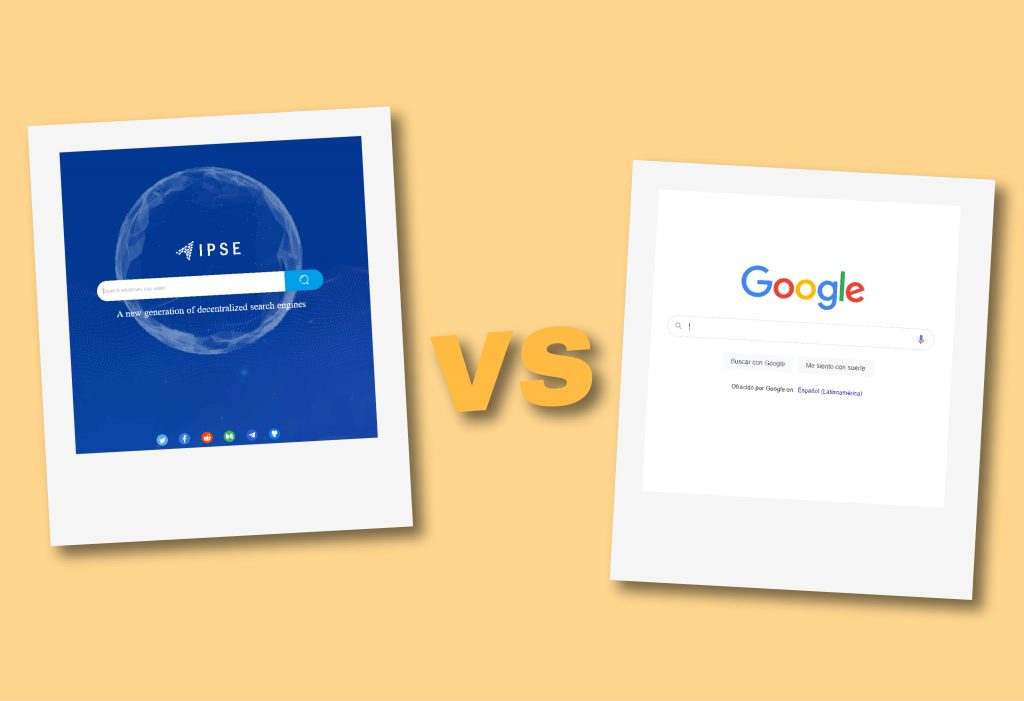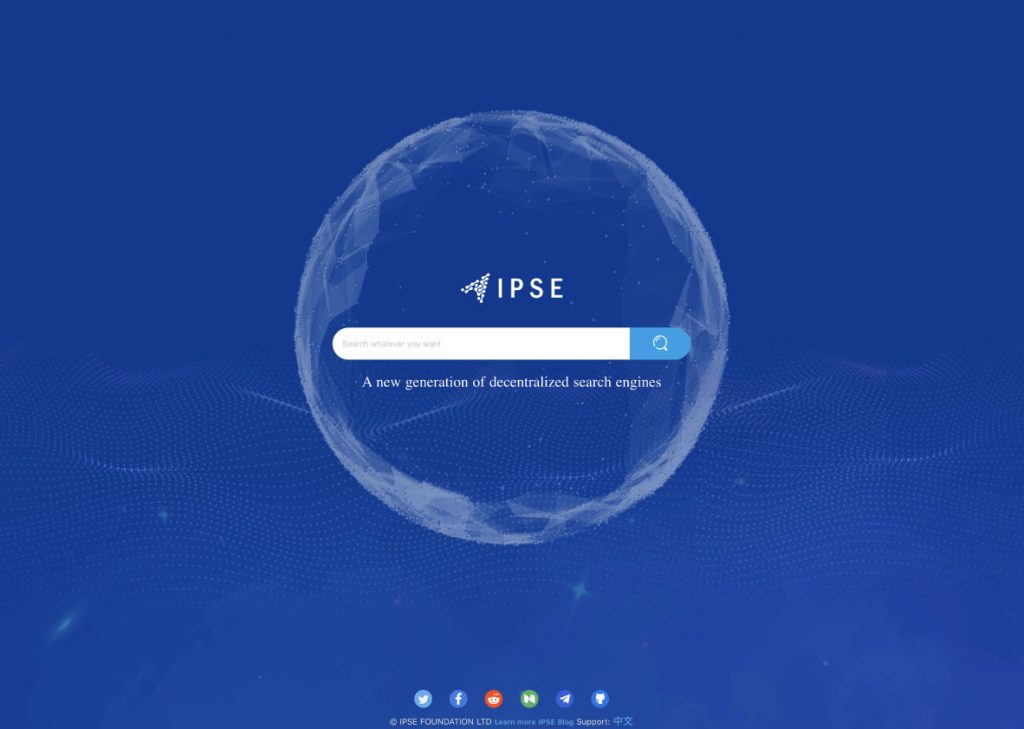
Table of Contents
ToggleAs explained on its official web page, InterPlanetary Search Engine (IPSE) is a revolutionary search engine, based on Interplanetary File System (IPFS) . IPSE is designed to help users quickly recover files on the IPFS network with smart contract protocol and uses the EOS blockchain payment ecosystem for its Token Economy.
Before understanding how IPSE works, it is important to understand what Interplanetary File System (IPFS) is.
Imagine you are right now on a web page created on IPFS, managed by smart contract and based on blockchain, whose contents are immutable, transparent, and distributed. It will seem like a pure fantasy but … all this exists and I will soon explain what it is.
What is Interplanetary File System (IPFS)

Maybe you never thought about it, but traditional search engines like Google have brought great benefits and have significantly improved our lives. However, about 80% of data shared on the Internet are in the hands of companies and Centralized search engines get big profits using user data and selling them to advertisers, thus putting data ownership at risk.
Created in 2015, IPFS (InterPlanetary File System) was created with the aim of putting an end to the monopoly of data controlled by centralized servers to the user/client side.
IPFS is a peer-to-peer hypermedia protocol distributed, whose goal is to connect all computer devices with the new protocol. IPFS aims to replace the domain-based address with a content-based address, that is, the content the user is looking for is not the domain but the address of the content itself and does not need to verify the identity of the sender, but only needs to verify the hash of the content. This system will pay off the fastest, safest and most open Web.
This protocol uses Filecoin as an incentive built on IPFS, addressing security and data storage and incentives to user engagement.
The main features of the IPFS protocol are:
- Permanently centralized file storage and sharing;
- Saving various types of hypermedial data through the P2P network;
- Content is identified by generating a unique hash value;
- Version control, traceable file change history.
How IPFS works
If you master a bit of tech, you probably know that each website is managed via a DNS (Domain Name System) and is located on a server that is associated with an IP address (eg 191.886.12.38) which is a numeric identifier code of a web page. This code is, for the convenience of the user, replaced and customized by a domain name chosen by the owner of the website. An example of a custom domain name is www.blog.bitnovo.com . In this way it is easier for the user to remember the website address or site name when accessing the desired content.
So what do IP, DNS and IPFS have in common?
DNS servers are responsible for matching each domain name with the corresponding IP addresse.
Technically the steps are as follows:
- You are trying to access the Bitnovo blog at this address:www.blog.bitnovo.com
- Your PC contacts a DNS server
- This server translates the name of the domain you typed into the corresponding IP address and searches it on the server where it is hosted.
If for example www.blog.bitnovo.com were uploaded and hosted on a File System distributed as IPFS, it would mean that Bitnovo, instead of the classic DNS server,would be using ENS, which is Ethereum Name Service, which is built through Smart Contracts on the Ethereum blockchain.
ENS allows to find resources both on the blockchain that out of it safely and in a decentralized way, making sure that all data is stored on a public, unchangeable and incorruptible register.
When you search for a domain name using the ENS server, you are searching on the blockchain for the last hash (a kind of unique fingerprint for each file or web page) that the site owner registered on the Smart Contract.
Once you have recovered the hash, you can use it on IPFS to access the corresponding document, and you will be sure that the page you visit will correspond to the latest version of the site registered by the owner.
IPFS provides a block storage model for high-speed content transmission, with hyperlinks to content.
With IPFS instead of searching for locations (servers) you search for the content itself making the request to provide the required file not to a single server,but to millions of computers able to provide a specific file. This is because this protocol distributes website components among all Internet users who have installed the client program on their computer. At the time of request, the IPFS system will automatically search for the stored pieces.
Benefits of Interplanetary Search Engine (IPSE)

Today we are witnessing an incredible evolution of information technology and, in particular, of the Internet.
In the era of big data and cloud computing even search engines are experiencing great changes.
However, the development of traditional search engine technology has remained somewhat behind as they are based on projects of centralized architecture, with a limited computing power that is not able to satisfy a large amount of data and information.
In addition, among the main problems that characterise traditional search engines are the following:
- Privacy issues for users.
- Unclear data properties.
- Excessive dependence on advertising.
- Fake information.
The goal of IPSE is to solve these limitations, improving the performance of distributed search engines, with the guarantee of greater reliability and scalability.
Among the main advantages and benefits of IPSE,the search engine based on IPFS and EOS ecosystems, are:
- Protection of data property
With IPSE, Internet users will not have to store their data by sharing it with internet giants but will be the exclusive owners of their data thanks to the decentralized data storage system. Also with IPSE can set your privacy preferences and get compensation in return.
- Incentive-sharing
IPSE’s free search system implements an incentive-sharing model to ensure a more accurate and content-rich distributed search engine.
- Research-based advertising platform
With traditional search engines, in the case of advertising, it is intermediaries who obtain the greatest advantages over Internet users and advertisers. With IPSE, advertisers can obtain data on customers’ shared preferences through a smart contract, paying them a reasonable compensation price and without going through an intermediary. Therefore, the user must not disclose the private data to anyone else except the advertiser.
- Token Economy system for content
Consumers can be rewarded with tokens by sharing their content with copyright through an economy token system based on an EOS payment system.
How to search on IPSE?

- To use Interplanetary Search Engine (IPSE),access to its web address.
- Type the keywords you want to search for, (as you would on google), press “Enter” or click the search icon to get your search results.
- There are several tabs that help to view content such as: html, video, image, audio, package, dir etc.
How to get bonuses and rewards on IPSE
Believe it or not,IPSE allows its users to receive rewards just to use its search engine.
When a user upload files to IPFS and add tags, will receive as a reward the token POST (which are the IPSE tokens).
The IPSE team believes that the token system is useful and can make the platform more attractive, offering benefits to users.
This way, with the help of the IPSE token (POST), users can help create a better Internet.
How to mine POST, the IPSE tokens?
This tutorial will teach you step by step how to mine POST, the IPSE token with your PC.
1: First, download the program IPFS desktop and install it on your computer. Keep IPFS running and make sure you are connected to the IPFS network.
2: Download and install Scatter. Scatter will be your wallet to store your EOS crypto. Set your password and click to create a new wallet. Once configured Scatter, import your private EOS keys to this wallet.
3: Enter the IPSE websiteon your computer and log in, your EOS account will be connected to IPSE via Scatter.
4: Go to the top-right section of the page, where you will see the name of your EOS wallet. Click “Label” and start uploading files to upload box to automatically add tag and click ‘return’ to start undermining. Once you have completed mining, you will receive your (POST) reward directly in your EOS wallet.
You can see thefull guide and detailed tutorial on how to mine IPSE visiting the official website of the project
IPSE, ADDITIONAL RESOURCES
If you want to learn more about this revolutionary search engine and want to try this tool, we recommend you read the additional resources of iPSE that you will find below.







